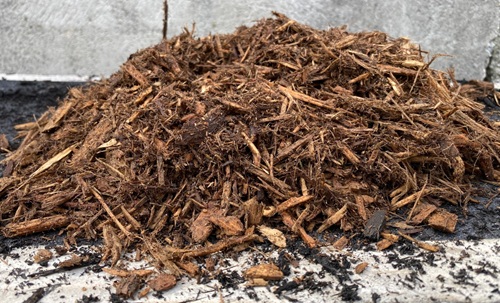Mulch plays a crucial role in gardening and landscaping, serving both functional and aesthetic purposes. Among the many types of mulch available, cedar mulch stands out for its pleasant aroma, durability, and pest-repelling properties. Derived from shredded or chipped cedar trees, this organic mulch is often used in flower beds, around trees, and in decorative landscape designs. However, like all gardening materials, cedar mulch has its advantages and disadvantages. This article explores the pros and cons of cedar mulch to help you decide if it’s the right choice for your garden or landscaping project.
What Is Cedar Mulch?

Cedar mulch is made from the bark and wood of cedar trees, commonly the Western Red Cedar. It is available in both shredded and chipped forms, dyed or natural, and is prized for its long-lasting aroma and color. Cedar mulch is used to suppress weeds, retain soil moisture, and enhance the overall appearance of garden beds. While many gardeners swear by it, others raise concerns about its cost, soil interaction, and potential environmental impact.
Pros of Cedar Mulch
1. Long-Lasting and Durable
One of the biggest advantages of cedar mulch is its longevity. Unlike softer wood mulches such as pine, cedar decomposes slowly due to its natural oils and dense composition. This means you won’t need to replace it as frequently, making it a cost-effective choice in the long run despite a higher initial price.
2. Natural Pest Repellent
Cedar wood contains aromatic compounds, particularly thujone and cedrene, which are known to repel insects like ants, moths, cockroaches, and termites. This natural repellent effect makes cedar mulch ideal for use around homes and in garden beds where pest control is a concern—without resorting to chemical treatments.
3. Aesthetic Appeal
Cedar mulch adds a clean, finished look to garden beds. Its rich, reddish-brown hue and uniform texture enhance the appearance of flower beds, shrub borders, and trees. Dyed cedar mulch is also available in various shades to match your garden design.
4. Pleasant Fragrance
Another standout feature is its distinctive, pleasant aroma. Many gardeners appreciate the fresh, woodsy scent of cedar mulch, which can make garden spaces more inviting and enjoyable.
5. Weed Suppression
Like other mulches, cedar mulch helps suppress weed growth by blocking sunlight and creating a barrier that makes it harder for weed seeds to germinate and grow. A 2–3 inch layer is typically effective for this purpose.
6. Soil Moisture Retention
Cedar mulch helps the soil retain moisture by reducing evaporation. This is particularly beneficial in hot and dry climates, as it reduces the need for frequent watering and keeps plant roots consistently moist.
Cons of Cedar Mulch
1. Higher Cost
Cedar mulch is generally more expensive than other types of organic mulch, such as pine bark, straw, or hardwood. While its durability can offset long-term costs, the upfront investment may not be feasible for budget-conscious gardeners or large-scale landscaping projects.
2. Potential Soil Acidity Impact
There’s some debate over whether cedar mulch affects soil pH. While it is often considered mildly acidic, most research suggests that its impact on soil acidity is minimal when applied as a top layer. However, gardeners with acid-sensitive plants may prefer to monitor soil pH levels when using cedar mulch extensively.
3. Slower Breakdown Means Less Soil Enrichment
Because cedar decomposes slowly, it contributes fewer nutrients to the soil over time compared to faster-decomposing organic mulches like compost, grass clippings, or leaf mold. If soil enrichment is a primary goal, cedar mulch may not be the most effective option.
4. Potential Allelopathic Effects
Some studies suggest that cedar mulch may exhibit allelopathic properties, meaning it could release chemicals that inhibit seed germination or plant growth. While these effects are generally minor and mostly affect small seeds or seedlings, it’s best to avoid placing cedar mulch directly around newly planted or sprouting plants.
5. Aromatic Oils May Irritate Some Plants or Pets
While the natural oils in cedar mulch are great for repelling insects, they may also irritate sensitive plants or pets. Some plants may react negatively to these oils if mulch is applied too thickly or too close to the stem. Pet owners should also be cautious, as some animals might have allergic reactions to cedar’s strong scent or compounds.
6. Fire Risk
Like all wood-based mulches, cedar is flammable. In fire-prone areas, using cedar mulch around the base of buildings may pose a risk. Alternatives like stone mulch or rubber mulch may be safer in such environments.
Tips for Using Cedar Mulch Effectively
-
Apply the right thickness: Use 2–3 inches of mulch for best results. Too little won’t suppress weeds effectively, while too much can suffocate roots or retain too much moisture.
-
Keep mulch away from stems and trunks: Maintain a 2-3 inch buffer around plant stems and tree trunks to prevent rot and fungal issues.
-
Monitor soil moisture: Cedar mulch retains moisture well, so reduce watering frequency to avoid root rot.
-
Use for established plants: Avoid using cedar mulch around seedlings or directly over seeds due to possible allelopathic effects.
Conclusion
Cedar mulch is a visually appealing, durable, and insect-repelling mulch choice that offers significant benefits for garden aesthetics and maintenance. Its natural fragrance, weed suppression, and moisture retention capabilities make it an excellent option for many gardeners. However, its higher cost, slower decomposition, and potential plant sensitivities are important to consider.
In the right context—especially for ornamental landscaping and pest control—cedar mulch is a standout option. But for vegetable gardens or nutrient-intensive soils, you may want to mix it with compost or opt for more nutrient-rich alternatives. By weighing these pros and cons, you can make an informed choice to keep your garden healthy, attractive, and thriving.



